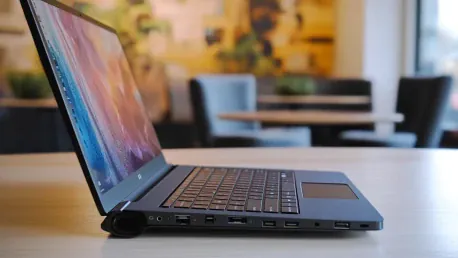In 2025, Lenovo aims to revolutionize the laptop market with its rollable laptop technology, potentially overshadowing current foldable designs. This innovation arrives amidst significant advancements in PC display technology, including Samsung’s folding monitors, Asus’s integration of Google TV within its monitors, and the emergence of 500Hz OLED gaming monitors. Moreover, the laptop display segment has seen substantial updates from ASUS and Lenovo with their second-generation dual-screen laptops, specifically the Zenbook Duo and Yoga Book 9i, respectively.
Introduction of Rollable Screen Technology
Central to this discussion is Lenovo’s introduction of its first rollable screen laptop, distinctively separate from its initial venture into foldable models in 2020 with the ThinkPad X1 Fold. This new model, named the ThinkBook Plus Gen 6, is set to be available by March 31, 2025. While it shares lineage with previous foldable innovations, the rollable screen technology distinguishes itself by addressing some of the persistent issues inherent to foldable designs and introducing new features aimed at enhancing user experience.
One of the key attractions of Lenovo’s rollable laptop is its extendable screen feature. With a simple button press or hand gesture, the screen enlarges from a native 14-inch size to 16.7 inches. This transition also shifts the screen’s orientation from landscape to portrait mode. The orientation shift is particularly advantageous for working with documents, browsing websites, or viewing social media content such as Instagram reels. The extended display adopts a 16×18 aspect ratio, comparable to having two stacked 16×9 monitors and mirrors LG’s DoubleUp PC monitor’s productivity-enhancing properties.
Unlike the mechanical intricacies and bulk of foldable laptops, Lenovo’s rollable screen laptop provides a more practical solution by offering a seamless transition between screen sizes. Current foldable and dual-screen laptops require repositioning and often deconstruction, especially when using Bluetooth keyboards, to capitalize on their display capabilities. In contrast, the rollable laptop provides a straightforward transformation through a mechanical extension, effectively simplifying the user’s interaction with the device and enhancing its overall usability.
Advantages of Rollable Laptops Over Foldable Models
Lenovo’s rollable screen laptop eschews the bulk and mechanical intricacies of foldable laptops, bringing forward three fundamental advantages that set it apart from its foldable counterparts. Firstly, it offers a user-friendly transformation between sizes. Current foldable and dual-screen laptops require repositioning and often deconstruction, especially with Bluetooth keyboards, to capitalize on their display capabilities. In contrast, the rollable laptop provides a seamless transition via a mechanical extension, thereby reducing the complex manipulation necessary with foldable displays. This simplicity in use represents a considerable leap forward in practical technology integration.
Secondly, the practicality of the rollable laptop shines in its form factor. Rollable laptops are inherently thinner and lighter due to their reduced layers compared to foldable counterparts. Foldable laptops must accommodate three layers: two for the screens and one for the keyboard, resulting in considerable added bulk. Conversely, the ThinkBook Plus Gen 6 is projected to weigh 3.73 pounds. While not quite feather-light, it is more manageable than the 4.2-pound ThinkPad X1 Fold 16 with its integrated keyboard. This reduced weight and slim profile make the rollable laptop a more portable and user-friendly option for consumers.
The third advantage lies in the port placement of rollable laptops. Foldable laptops often have complicated port configurations to account for their various orientations in use, leading to cables protruding awkwardly and potentially disrupting the device’s usability. Rollable laptops, however, maintain the ports’ positions consistent with standard laptop design, eliminating this inconvenience. This consistent port placement streamlines the user experience, ensuring that cables and peripherals can connect as seamlessly as they would with traditional laptops.
Challenges and Limitations of Rollable Laptops
Nevertheless, early adoption of rollable laptops such as the ThinkBook Plus Gen 6 comes with its own set of challenges. It is priced at $3,499, substantially higher than the foldable ThinkPad X1 Fold 16, which is approximately $1,000 less. This premium pricing might be prohibitive for some users who are looking for the latest technology but are also budget-conscious. Furthermore, the inability of the rollable screen to provide a full landscape mode in its expanded state limits its versatility in scenarios that demand a large display area, marking a critical divergence from foldable laptops that can be fully utilized as expansive tablets.
Additionally, the reliance on a motor-driven mechanism for the rollable screen poses potential durability issues. Despite Lenovo’s assurances of rigorous testing, the long-term reliability of the motor remains a concern. This concern is especially pronounced when compared to the manual adjustments of dual-display or even foldable screens, which also face their own unique durability challenges. As the rollable mechanism is a critical component of the laptop, any mechanical failure could significantly impact the device’s functionality and user satisfaction, making durability a key area to monitor as these laptops enter the market.
The Future of Laptop Display Technology
In 2025, Lenovo intends to revolutionize the laptop industry with its new rollable laptop technology, which may outshine the current foldable designs. This groundbreaking innovation is set to emerge in a period of substantial progress in PC display technology. We’ve witnessed major developments like Samsung’s folding monitors, Asus’s monitors that incorporate Google TV, and the introduction of 500Hz OLED gaming monitors, redefining user expectations. Furthermore, the laptop display market has seen significant upgrades from major players like ASUS and Lenovo, with the release of their second-generation dual-screen laptops. ASUS debuted the Zenbook Duo while Lenovo unveiled the Yoga Book 9i. These models have set a new standard in multitasking and productivity, boasting enhanced performance and user experiences. Such advancements indicate a fast-evolving landscape in computer technology as major brands continuously strive to innovate and improve display technologies, making 2025 a potentially transformative year for how we use and perceive laptops.









